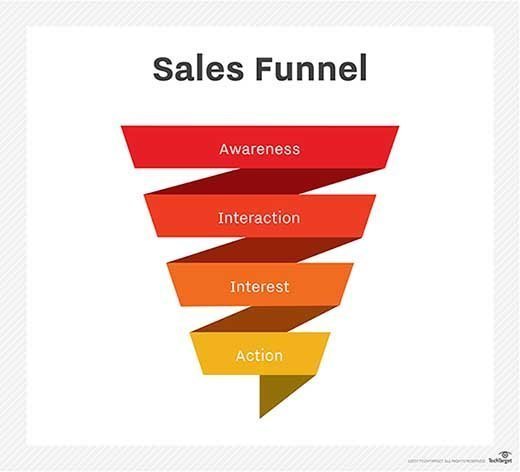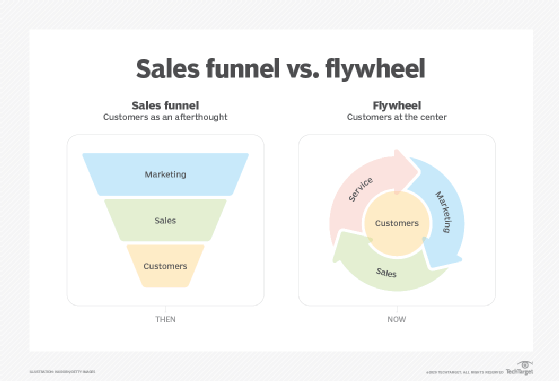What is a sales funnel? Everything you need to know
A sales funnel, also called a purchase funnel, is the visual representation of the customer journey, depicting the sales process from awareness to action. The funnel, which is also referred to as a marketing funnel or revenue funnel, illustrates the idea that every sale begins with many potential customers and ends with a much smaller number of people who make a purchase.
In between the beginning and end of the funnel, potential customers and vendors typically have many interactions to help prospects learn about the product or service prior to their purchasing decisions. The sales funnel is applicable to both business-to-business and business-to-consumer industries.
Companies rely on their sales and marketing teams to guide the customer through the sales funnel and build customer loyalty, taking advantage of content marketing, customer data analytics and the two-way communication that social media marketing provides.
Why is implementing a sales funnel important?
There are several reasons why implementing a sales funnel is important, including the following:
- Creates customers. The point of the sales funnel is to take a business's target audience and move the members through a series of steps that eventually results in them becoming customers.
- Generates referrals. In addition to acquiring a base target audience and group of customers, an effective sales funnel spurs satisfied customers to refer other prospects who weren't in the original target audience.
- Monitors and tracks. A sales funnel lets organizations see how well each step of the sales process is working and make adjustments as needed. This helps ensure efficient use of time and sales resources. Pushing customers through the sales funnel creates useful feedback.
- Focuses efforts. A sales funnel narrows a business's focus to a specific group of prospects. This makes it easier to reach target audience members and convert them into customers when they reach the bottom of the funnel. A sales funnel requires potential customers to go through a series of steps eventually leading to a purchase, weeding out unqualified prospects.
6 stages of a sales funnel
The stages of a sales funnel vary by company and the sales funnel template they use. However, they typically follow these six steps:
- Awareness. The awareness stage includes the largest number of customer prospects. They have a problem or specific pain point and in searching for a solution, have become aware of an organization that might solve it. They get information via content marketing, email campaigns, webinars, social media marketing or word of mouth.
- Interest. The prospect asks questions about the organization's product or service, demonstrating interest. This stage can include vendors sharing pricing information and sales offers, and prospects doing further research into the different options available.
- Evaluation. The prospect conducts competitive research to determine if the organization's product best meets their needs.
- Engagement. The customer requests more detailed information from the organization about the product or service. At this stage, the number of customer prospects decreases, but the possibility of a sales conversion increases.
- Action. This is the decision stage that all the previous stages of the sales funnel lead to. At this point, the customer has decided whether to purchase the product. If the prospect declines to make a purchase, the organization uses other marketing strategies to ensure their product stays top of mind.
- Retention. After a successful sale, the next stage is where the vendor continues having frequent interactions with the customer as part of a customer retention strategy. The goal at this stage is to determine any future needs the customer might have and encourage future sales.

How to build a sales funnel for your business
There are several best practices a business should follow to build a successful sales funnel:
- Analyze audience behavior. This involves defining a target audience -- the people who will be drawn into the top of the funnel. For a web-based business, this might mean analyzing metrics on how prospects use the site, including what they find most interesting and the bounce rate, which shows the amount of time visitors are on the business's webpages.
- Capture audience attention. There needs to be something that initially draws an audience into the funnel. This could include rich media such as infographics, videos or advertisements.
- Direct the audience somewhere. Once their attention is captured, prospects need a place to go. For a web-based business, this means using an attractive landing page that gathers data from the user experience and features a call to action that gets the prospect to engage.
- Generate leads. Once the previous three steps are completed, it's important to continue to generate new leads to add to the funnel. There are several lead generation and customer relationship management (CRM) tools that businesses use to automate this process, including Salesforce and HubSpot.
- Maintain relationships. Once leads are generated and captured, the most important step is to nurture these prospects into customers. The point of the sales funnel is to generate customers.
Sales funnel metrics
Companies use various metrics to analyze and score leads and prospects during the sales cycle to evaluate the success of their sales teams. Examples of lead-to-revenue management metrics include the following:
- Average order value. This shows how much revenue on average is generated with each order or purchase. This is important because it shows how valuable the average individual customer is.
- Customer lifetime value. This quantifies the value of every sales opportunity in the funnel.
- Conversion rate. This is the number of customer conversions divided by the total number of site visitors or those who have otherwise engaged with the business's product or service without yet becoming a customer. This is the percentage of leads that turn into paying customers.
- Entrances. These are the number of leads that enter the funnel during a specific period of time.
- Follow-ups. This is the number of prospects that follow up with and respond to the initial marketing efforts of the business.
- Flow rate. Optimal flow rate is the average amount of time leads are in each stage of the funnel.
- Total revenue. This is the total amount of revenue generated by all sales in a given period. This is a good measure of overall sales efficiency.
- Win rate. This is the percentage of deal closings divided by the total number of deals in the pipeline.
Sales funnel vs. sales pipeline
A funnel and sales pipeline both visualize how vendor-customer relations end in successful sales. However, they display customer journeys through the buying process differently. A pipeline shows the journey from the point of view of the sales rep or the sales team. A sales funnel looks at the same journey from the buyer's perspective, from awareness of a product, to the interest stage, to the actual purchase.
Sales funnels and sales pipelines are structured differently. A pipeline is displayed as a timeline of actions taken by a vendor, ending in a successful sale and further efforts to retain a customer. In a sales funnel, the funnel shape shows how a pool of qualified leads is narrowed into a smaller group of paying customers. Along the way, high-quality leads interact with the vendor to find out more about a product.
How to optimize and manage your sales funnel
In addition to the best practices mentioned above, there are marketing automation software and CRM tools that can help businesses get the most out of their sales funnel. Among the features that are useful in real-life sales funnel examples are the following:
- Triggered email. Email marketing often relies on automated emails triggered by a user's browsing behavior.
- SMS and push notifications. SMS messages and push notifications are automated for mobile marketing campaign software.
- Return-on-investment reporting. ROI is monitored as an indicator of overall funnel health.
- Lead management. A lead activity summary enables refined campaign targeting.
- Offer management. A rules-based offer catalog enables marketers to assign weight to and track presentation of offers to customers.
- Knowledge bases. A knowledge base provides employee and customer support through an online library of reference documents.
- Lead generation. Automated features monitor customer interactions with landing pages as well as built-in automated landing page designs.
- Sales dashboard. Reporting and dashboards provide an easy display of sales performance and measurement.
- Sales alignment. The software enables granular analysis of an individual salesperson's activity within the larger sales strategy.
- SEO recommendations. Recommendations for making landing pages more attractive to customers and making blog posts perform better in search engines.
- Customer data curation features. Customer data is analyzed, optimized and organized for ease of use.
- Customer feedback features. Feedback is solicited through triggered emails and other software features.
- Social media management. Customers are able to monitor user feedback on social media.
- Multiple versions. Sales and marketing software offers different tiers, from a free trial to pro plan.

In today's age of the customer, the journey a customer takes -- sometimes referred to as the customer lifecycle -- is less likely to be linear. For that reason, some experts prefer a flywheel model, which puts the customer at the center of an organization's marketing efforts. However, the flywheel isn't as granular as the sales funnel model in describing the effort involved in converting a prospect into a sale.
The goal of a sales funnel is to take prospective customers in and nurture them into true customers. Learn six ways to create a customer experience that helps ensure sales success.





